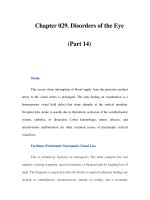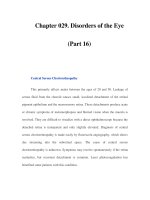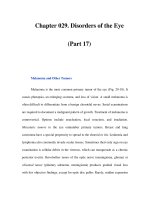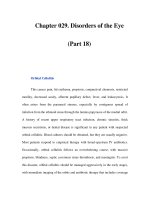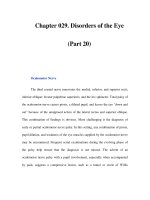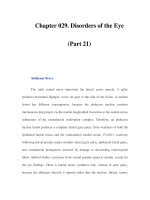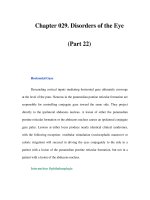Chapter 029. Disorders of the Eye (Part 18) ppt
Bạn đang xem bản rút gọn của tài liệu. Xem và tải ngay bản đầy đủ của tài liệu tại đây (12.75 KB, 5 trang )
Chapter 029. Disorders of the Eye
(Part 18)
Orbital Cellulitis
This causes pain, lid erythema, proptosis, conjunctival chemosis, restricted
motility, decreased acuity, afferent pupillary defect, fever, and leukocytosis. It
often arises from the paranasal sinuses, especially by contiguous spread of
infection from the ethmoid sinus through the lamina papyracea of the medial orbit.
A history of recent upper respiratory tract infection, chronic sinusitis, thick
mucous secretions, or dental disease is significant in any patient with suspected
orbital cellulitis. Blood cultures should be obtained, but they are usually negative.
Most patients respond to empirical therapy with broad-spectrum IV antibiotics.
Occasionally, orbital cellulitis follows an overwhelming course, with massive
proptosis, blindness, septic cavernous sinus thrombosis, and meningitis. To avert
this disaster, orbital cellulitis should be managed aggressively in the early stages,
with immediate imaging of the orbits and antibiotic therapy that includes coverage
of methicillin-resistant Staphylococcus aureus. Prompt surgical drainage of an
orbital abscess or paranasal sinusitis is indicated if optic nerve function
deteriorates despite antibiotics.
Tumors
Tumors of the orbit cause painless, progressive proptosis. The most
common primary tumors are hemangioma, lymphangioma, neurofibroma, dermoid
cyst, adenoid cystic carcinoma, optic nerve glioma, optic nerve meningioma, and
benign mixed tumor of the lacrimal gland. Metastatic tumor to the orbit occurs
frequently in breast carcinoma, lung carcinoma, and lymphoma. Diagnosis by
fine-needle aspiration followed by urgent radiation therapy can sometimes
preserve vision.
Carotid Cavernous Fistulas
With anterior drainage through the orbit these produce proptosis, diplopia,
glaucoma, and corkscrew, arterialized conjunctival vessels. Direct fistulas usually
result from trauma. They are easily diagnosed because of the prominent signs
produced by high-flow, high-pressure shunting. Indirect fistulas, or dural
arteriovenous malformations, are more likely to occur spontaneously, especially in
older women. The signs are more subtle and the diagnosis is frequently missed.
The combination of slight proptosis, diplopia, enlarged muscles, and an injected
eye is often mistaken for thyroid ophthalmopathy. A bruit heard upon auscultation
of the head, or reported by the patient, is a valuable diagnostic clue. Imaging
shows an enlarged superior ophthalmic vein in the orbits. Carotid cavernous
shunts can be eliminated by intravascular embolization.
Ptosis
Blepharoptosis
This is an abnormal drooping of the eyelid. Unilateral or bilateral ptosis can
be congenital, from dysgenesis of the levator palpebrae superioris, or from
abnormal insertion of its aponeurosis into the eyelid. Acquired ptosis can develop
so gradually that the patient is unaware of the problem. Inspection of old
photographs is helpful in dating the onset.
A history of prior trauma, eye surgery, contact lens use, diplopia, systemic
symptoms (e.g., dysphagia or peripheral muscle weakness), or a family history of
ptosis should be sought. Fluctuating ptosis that worsens late in the day is typical of
myasthenia gravis.
Examination should focus upon evidence for proptosis, eyelid masses or
deformities, inflammation, pupil inequality, or limitation of motility. The width of
the palpebral fissures is measured in primary gaze to quantitate the degree of
ptosis. The ptosis will be underestimated if the patient compensates by lifting the
brow with the frontalis muscle.
Mechanical Ptosis
This occurs in many elderly patients from stretching and redundancy of
eyelid skin and subcutaneous fat (dermatochalasis). The extra weight of these
sagging tissues causes the lid to droop. Enlargement or deformation of the eyelid
from infection, tumor, trauma, or inflammation also results in ptosis on a purely
mechanical basis.
Aponeurotic Ptosis
This is an acquired dehiscence or stretching of the aponeurotic tendon,
which connects the levator muscle to the tarsal plate of the eyelid. It occurs
commonly in older patients, presumably from loss of connective tissue elasticity.
Aponeurotic ptosis is also a frequent sequela of eyelid swelling from infection or
blunt trauma to the orbit, cataract surgery, or hard contact lens usage.

